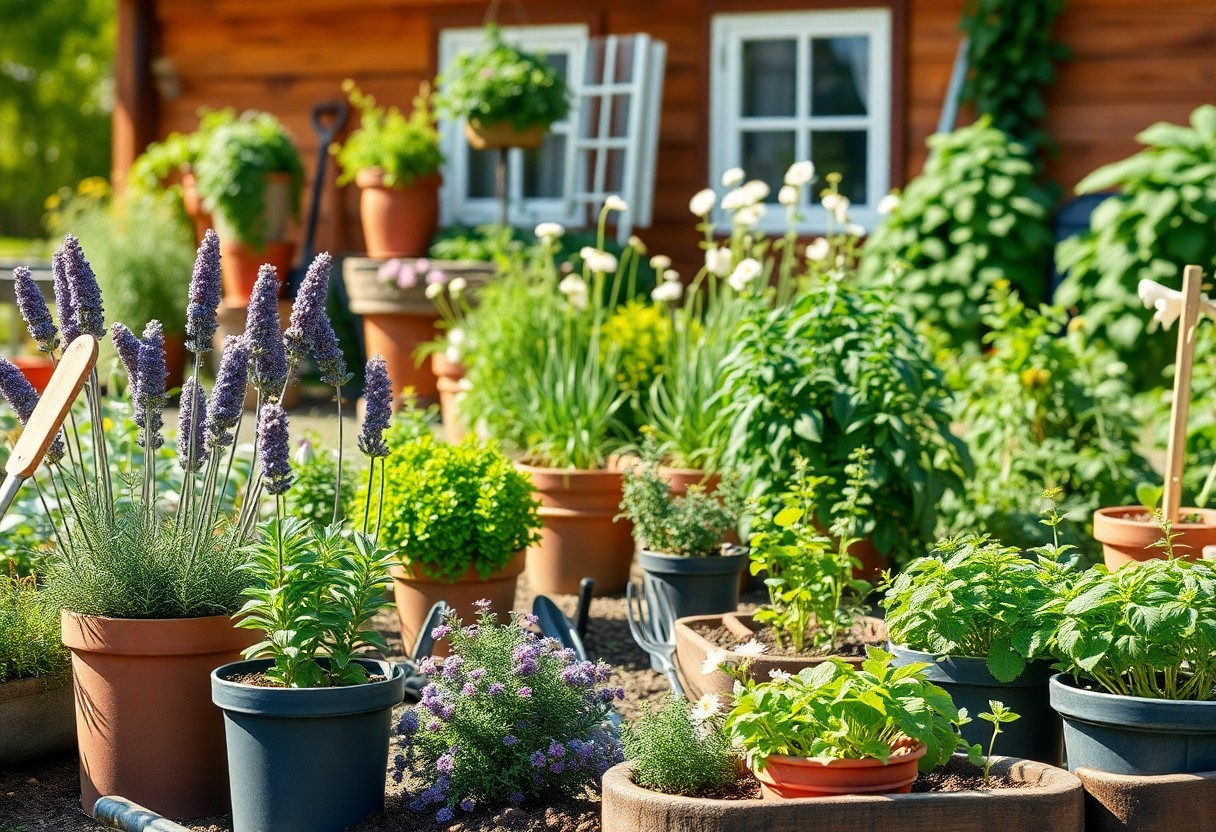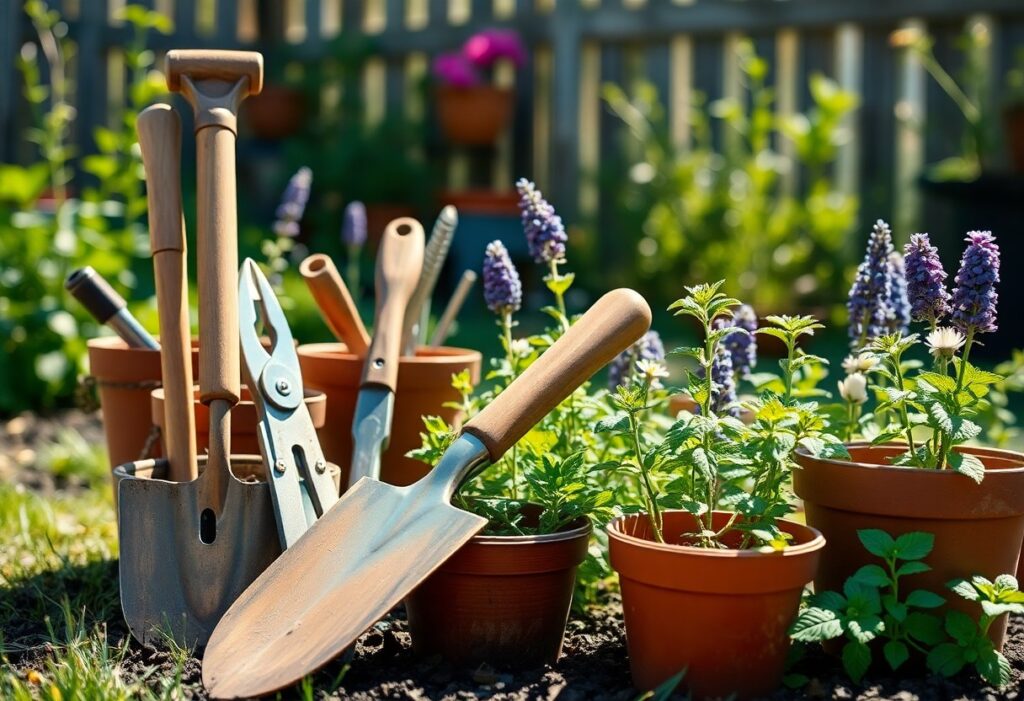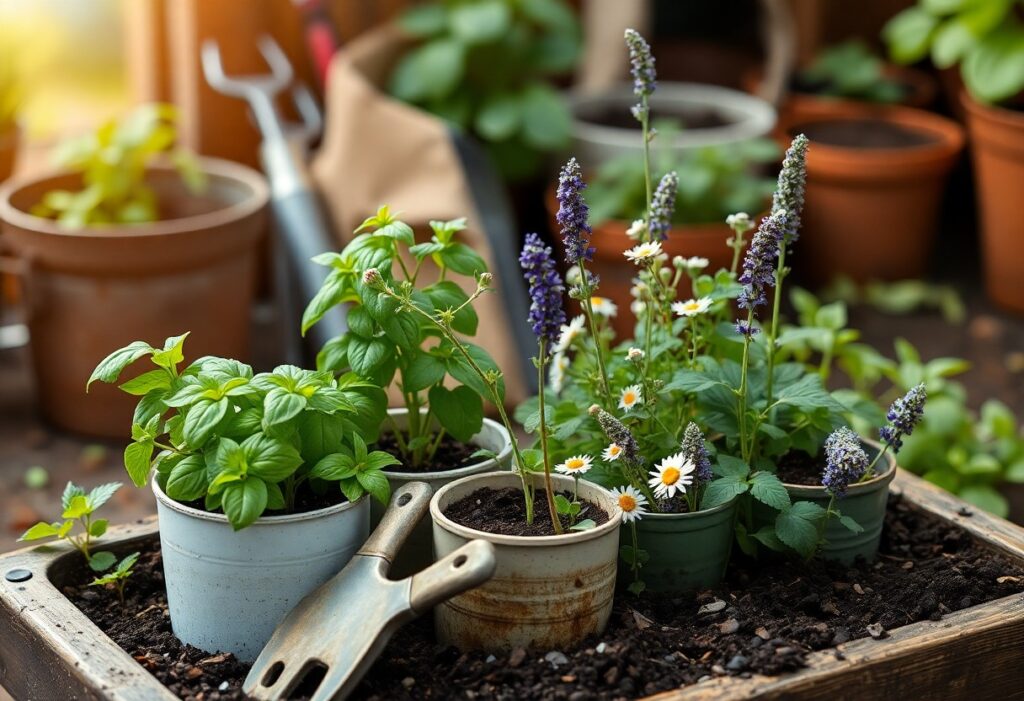There’s a growing interest in the benefits of having a medicinal garden at home, and I’m here to guide you through the process. By growing your own herbs, you can enhance your health and wellness routine naturally. I will share necessary tips and tools that will enable you to cultivate your garden effectively, ensuring you have access to healing plants right at your fingertips. Let’s explore how to transform your space into a sanctuary for both mind and body, making your home a hub for natural remedies.
Key Takeaways:
- Choosing the Right Herbs: Select herbs that are well-suited for your climate and have medicinal properties relevant to your health needs, such as lavender for relaxation or peppermint for digestion.
- Soil and Sunlight: Ensure your garden has well-draining soil and receives adequate sunlight, ideally 6-8 hours a day, to promote healthy growth and potent medicinal qualities.
- Maintenance and Care: Regularly water, prune, and check for pests to keep your plants thriving; this ensures you have fresh herbs at hand for health and wellness applications.
Benefits of a Medicinal Garden
The benefits of starting a medicinal garden at home extend beyond just having easy access to herbs; they play a vital role in enhancing both personal wellbeing and the environment. By growing your own medicinals, you are not only improving your health but also cultivating a deeper connection with nature. The satisfaction of nurturing plants and watching them thrive can boost your mental health, making the gardening experience rewarding and therapeutic. Plus, home-grown herbs are often more potent and fresher than store-bought alternatives, ensuring you get the most out of your health practices.
Health Advantages
An incredible aspect of a medicinal garden is its ability to provide natural remedies right at your fingertips. By cultivating herbs like lavender, peppermint, and immunity-boosting echinacea, you can harness their healing properties for various ailments, from stress relief to digestive issues. Having these herbs readily available promotes a holistic approach to health, allowing you to incorporate natural ingredients into your daily routines without relying solely on pharmaceuticals.
Environmental Impact
With the increasing awareness of sustainability, establishing a medicinal garden at home contributes positively to the environment. Not only do these gardens promote biodiversity, but they also reduce the need for commercial farming practices that can harm ecosystems. By planting your own herbs, you help decrease carbon emissions associated with transporting goods from farm to store. Furthermore, many medicinal plants attract beneficial insects and pollinators, promoting a healthier garden ecosystem.
Understanding the environmental impact of your gardening choices is imperative for creating a sustainable future. By utilizing organic practices and avoiding chemical pesticides or fertilizers, you contribute to a cleaner, healthier environment. Additionally, the small biodiversity your garden supports is important for the local ecosystem, as it helps sustain beneficial insects and birds that can control pest populations naturally. Ultimately, your medicinal garden serves as a microcosm of ecological health, benefiting both you and the surrounding environment.
Selecting the Right Location
Assuming you’ve decided to commence on the rewarding journey of creating a medicinal garden, one of the first and most important steps is selecting the right location. The site you choose will significantly impact the health and growth of your herbs. I recommend looking for a space that offers ample sunlight, good air circulation, and accessibility for regular maintenance. You might consider a south-facing area of your yard or even a sunny balcony if you are limited in outdoor space. Keeping your herbs close to your kitchen can also encourage you to incorporate them into your daily wellness routine.
Sunlight Requirements
At the heart of a thriving medicinal garden is sunlight. Most herbs require at least six hours of direct sunlight each day to bloom and flourish. I’ve found that sun exposure not only enhances the taste and potency of the herbs but also plays a vital role in their medicinal properties. As you plan your garden, observe how sunlight travels across your chosen location throughout the day. If your area receives less than the required sunlight, consider using reflective surfaces or growing herbs in containers that can be moved to sunnier spots.
Accessibility and Protection
At the same time, it’s necessary to ensure that your garden is both accessible and well-protected. You want to be able to easily reach your herbs for watering, harvesting, and maintaining their health. Think about pathways and the arrangement of plants that will make it convenient for you to care for your garden without damaging nearby herbs. Additionally, consider potential threats to your garden, such as pets, pests, or harsh weather conditions. A fence or raised beds can provide a protective barrier while still allowing you to enjoy your green space.
Understanding the balance between accessibility and protection will enhance your gardening experience. You should also take steps to safeguard your herbs from common garden pests. Using organic insect repellents or planting natural deterrents can be beneficial. It’s also helpful to choose sturdy containers if you’re gardening in pots; this not only protects your herbs from animals but also makes it easier for you to move them in case of extreme weather conditions. By selecting an optimal location for sunlight, accessibility, and protection, you can create a successful medicinal garden that thrives in your home environment.
Choosing Medicinal Herbs
Now that you’ve made the decision to start your medicinal garden, the next step is to choose which herbs to cultivate. The variety of medicinal herbs available can be overwhelming, but focusing on those that resonate with your health needs and culinary tastes can simplify the process. I often suggest starting with a few popular choices, such as chamomile, peppermint, and lavender. Each of these herbs has unique properties that contribute to wellness—chamomile is renowned for its calming effects, peppermint aids digestion, and lavender is excellent for relaxation and sleep.
Popular Medicinal Herbs to Grow
Around my garden, I find that the following medicinal herbs stand out. Echinacea is a fantastic choice for boosting the immune system, while ginger supports digestion and may reduce inflammation. Adding rosemary not only enhances your culinary creations but also provides antioxidant benefits. These herbs are relatively easy to grow and can be used fresh or dried, making them valuable additions to any herbal collection.
Understanding Planting Zones
Beside selecting the right herbs, understanding your planting zone is vital for the success of your garden. The United States Department of Agriculture (USDA) has classified the country into various planting zones, each defined by its climate and temperature ranges. I encourage you to check which zone you reside in, as this information will help you determine the best herbs to grow at home. Specific herbs thrive in certain conditions, and selecting those suited to your zone will greatly increase your chances of success.
Understanding your planting zone allows you to select herbs that can endure your local climate, ensuring they flourish in your home garden. For instance, I’ve found that hardy herbs like thyme and oregano are perfect for warmer climates, while tarragon and sage perform well in cooler zones. Additionally, being aware of your zone guides when to start planting—some herbs flourish in early spring, while others may prefer a summer sowing. By aligning your herb choices with your zone, you pave the way for a thriving medicinal garden that enriches your health and wellness journey.
Preparing the Soil
Many aspiring herbalists overlook the importance of soil preparation when starting their medicinal garden. The quality of your soil directly influences the health and efficacy of the herbs you plan to grow for health and wellness. Before sowing any seeds, it’s imperative to cultivate a healthy foundation that can sustain your plants. This involves not just digging and turning the soil but understanding its composition and potential deficiencies. Knowing what nutrients your soil lacks and what types of amendments can enhance its quality is key to creating a thriving medicinal garden right at home.
Soil Testing and Amendments
An important first step in preparing your soil is conducting a soil test. This process will provide valuable information about your soil’s pH levels, nutrient content, and organic matter percentage. Many local agricultural extensions offer affordable testing kits or services that analyze your soil and give a detailed report. Once you have your results, you can identify the specific amendments your soil needs to promote optimal growth for your desired medicinal herbs, whether that means adding organic compost, lime for acidity adjustment, or other minerals.
Best Practices for Soil Preparation
Best practices for soil preparation are vital for ensuring a rich growing environment for your herbs. Start by clearing the area of weeds, rocks, and debris, followed by turning the soil to a depth of at least 12 inches to aerate it properly. As I incorporate organic compost and other recommended amendments based on soil test results, I ensure that the mixture is well-integrated throughout the soil. Keeping the soil moist but not overly saturated is imperative, as it promotes beneficial microbial activity while preventing root rot. Additionally, I consider the seasonality of my gardening efforts; waiting for the right time to work on the soil can enhance its texture and nutrient availability, setting the stage for robust growth during the planting phase.
To gain the best results, regularly monitoring your soil’s condition is important. Incorporate seasonal cover crops to prevent erosion and maintain soil structure. You may also want to consider practicing crop rotation to maintain a balance of nutrients in the soil over time. With these preparations, your medicinal garden can flourish, providing an abundant supply of herbs for your health and wellness journey.

Planting Techniques
Once again, it’s time to roll up your sleeves and investigate the heart of your medicinal garden: the planting techniques. Whether you’re a seasoned gardener or a novice, understanding the different ways to introduce plants into your garden can significantly impact their growth and effectiveness. As I begin on this journey, I find that choosing the right method can make the process smoother and more fruitful.
Seed vs. Seedling
At the beginning of your medicinal garden, you might wonder whether to start with seeds or seedlings. Using seeds can be a rewarding and cost-effective approach. There’s something magical about watching them sprout and grow from their infancy. However, this method requires patience and nurturing until they are strong enough to thrive in the garden. On the other hand, seedlings offer the advantage of a head start; they’re already established and can lead to quicker harvests. I often recommend using seedlings for herbs like basil and rosemary, which can be a bit more challenging to start from seeds.
Layout and Spacing Considerations
Behind every successful medicinal garden is a well-thought-out layout and proper spacing. To ensure that your herbs have the best chance to flourish, it’s important to consider their specific growth requirements. Some herbs, such as chives and cilantro, can be planted closely together, while others, like mint and sage, need more room to spread. I typically leave enough space between plants to allow for air circulation, which helps to minimize the risk of disease.
Considering the layout of your garden also involves thinking about sunlight and moisture needs. Placing taller plants like lemon balm in the back of a raised bed will ensure that they don’t overshadow shorter herbs like thyme or oregano. Moreover, maintaining adequate spacing helps prevent overcrowding, which can lead to competition for nutrients and undesirable outcomes. A well-planned design allows your medicinal garden to thrive, providing you with a bountiful supply of fresh herbs for health and wellness.
Maintenance and Care
All gardens, including medicinal ones, require regular attention to thrive. To ensure your medicinal herbs flourish, you need to focus on fundamental aspects like watering and fertilization. Consistent watering is vital, as herbs typically need about an inch of water per week, depending on your climate. I recommend checking the soil moisture frequently; if the top inch feels dry, it’s time to water. On the other hand, overwatering can lead to root rot, which can be particularly detrimental to your herbs. Concerning fertilization, using an organic fertilizer every few weeks during the growing season can give your plants the necessary nutrients to produce high-quality leaves that are rich in medicinal properties.
Watering and Fertilization
Any good gardener knows that the right amount of water is key to healthy plants. In my experience, it’s also effective to use a drip irrigation system or soaker hoses to provide consistent moisture without drowning your plants. For fertilization, selecting a balanced organic option will promote healthy growth without the risk of chemical buildup, ensuring your herbs remain safe for medicinal use. As I work on my garden, I find it rewarding to observe the influence of the right care — my plants often respond positively, becoming lush and vibrant.
Pest and Disease Management
Against all odds, pests and diseases can pose a significant risk to your medicinal garden. Maintaining a close watch on your plants is vital; look for early signs of infestation or disease, such as discolored leaves or unusual spots. It’s vital to act quickly by applying organic treatments—like neem oil or insecticidal soap—to manage pests without harming your plants or the environment. Furthermore, planting companion herbs that deter pests can naturally protect your garden while allowing you to cultivate a diverse range of medicinal plants.
Consequently, staying proactive in pest and disease management can save your garden from potential threats. Regular inspections for aphids, spider mites, or fungal infections are beneficial; even a small problem can escalate quickly. Engaging in pest control from the beginning can make a significant difference. If you notice your plants struggling, consider rotating your herbs or introducing beneficial insects like ladybugs to keep the pests at bay. Your efforts will not only protect your plants but also enhance the overall health of your home medicinal garden.
Final Words
Ultimately, begining on the journey of creating a medicinal garden at home is a rewarding venture for both your health and your well-being. By following this step-by-step guide, I have equipped you with the necessary tools and knowledge to confidently select and cultivate herbs that can enhance your life. Whether you’re looking to alleviate stress, boost your immune system, or simply enjoy the fresh flavors of homegrown plants, every effort you put into your garden will yield both physical and emotional benefits.
Your medicinal garden doesn’t have to be extensive to be effective; even a small collection of herbs can provide you with a wealth of remedies and culinary delights. As you nurture your plants, you’ll gain a deeper understanding of their properties and uses, fostering a sense of connection to the earth and its healing abilities. So, take the plunge, dig into the soil, and allow the therapeutic properties of these herbs to enrich your everyday life. Happy gardening!
FAQ
Q: What are the best herbs to start with in a medicinal garden?
A: Some of the best herbs for beginners include chamomile, peppermint, basil, and calendula. These herbs are easy to grow, require minimal maintenance, and can be used for various health benefits, such as soothing digestive issues, reducing stress, and promoting relaxation.
Q: What type of soil is ideal for a medicinal garden?
A: Well-draining soil is imperative for a medicinal garden. A mix of potting soil and compost works well, as it provides the necessary nutrients while allowing excess water to drain away. Additionally, consider testing your soil’s pH; most medicinal herbs prefer slightly acidic to neutral soil (pH 6.0 to 7.0).
Q: How much sunlight do medicinal plants need?
A: Most medicinal herbs thrive in full sun, which means they need about 6-8 hours of direct sunlight each day. If you have limited sun exposure, consider herbs like mint or parsley, which can tolerate partial shade. Plant placement is key to ensuring they receive adequate light for optimal growth.
Q: How can I ensure my medicinal garden is pest-free naturally?
A: To keep pests at bay, you can introduce beneficial insects like ladybugs and lacewings, which prey on harmful pests. Additionally, planting herbs such as basil, rosemary, and marigolds can help deter unwanted insects. Regularly inspecting your plants and using companion planting techniques can also contribute to a healthier garden.
Q: What are some common uses for herbs grown in a medicinal garden?
A: Herbs from a medicinal garden can be used in various ways. For example, chamomile can be brewed into tea for relaxation, while peppermint can aid digestion. You can also prepare herbal infusions, tinctures, and salves for topical applications. Experimentation is key, so find what works best for your wellness needs!


